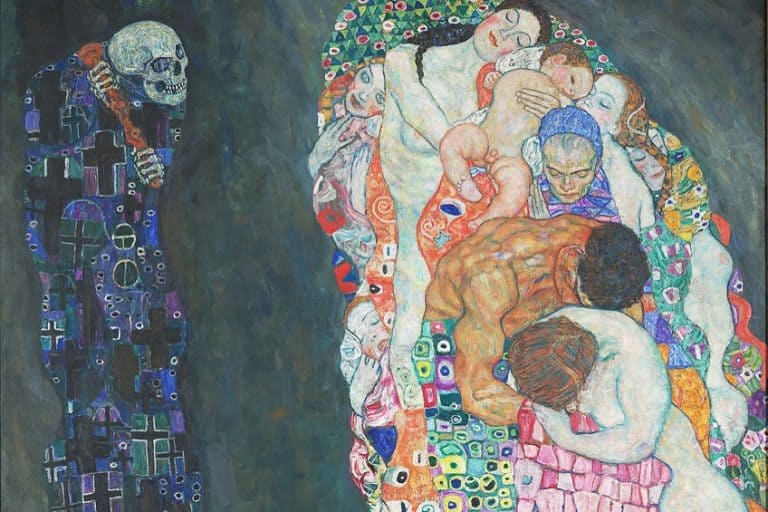“The Ten Largest” Paintings by Hilma af Klint – An Artistic Analysis
Hilma af Klint, a pioneering Swedish artist born in 1862, holds a significant place in the history of abstract art with her groundbreaking series known as The Ten Largest paintings. Created between 1907 and 1908, these monumental works not only showcase af Klint’s remarkable talent but also reflect her deep engagement with spirituality, theosophy, and the unseen realms of existence. Each canvas, towering in size and rich in symbolism, invites viewers into a world where art becomes a bridge between the material and the spiritual, challenging conventional notions of representation and perception. Let’s delve into the captivating journey of these awe-inspiring creations and unravel the mysteries they hold.
Key Takeaways
- Hilma af Klint was a pioneer in abstract art, notably through her series The Ten Largest.
- The Ten Largest explores profound themes of life’s stages, infused with spiritualism and natural motifs.
- Af Klint’s innovative use of abstract symbolism in painting had a lasting impact on the art world.
The Genesis of The Ten Largest
| Artist | Hilma af Klint (1862 – 1944) |
| Date Created | 1907 – 1908 |
| Medium | Oil and tempera on paper |
| Genre | Abstract art and Spiritual art |
| Period/Movement | Early Abstraction and Spiritualism |
| Dimensions (cm) | Each painting: 328 x 240 |
| Series/Versions | Series of 10 paintings |
| Where Is It Housed? | Moderna Museet, Stockholm, Sweden |
| What It Is Worth | Priceless, considered pioneering works of abstract art |
Hilma af Klint’s body of work, especially her series The Ten Largest, marks a significant milestone in the history of abstract art. Painted between 1907 and 1908, these works predate the recognized advent of European abstraction and represent Af Klint’s exploration into the spiritual dimensions of human existence. The paintings stand as a testament to her innovative spirit and her break from traditional representational art. The monumental size of the canvases, each measuring about three meters in height, was a bold statement of her intent to convey grand spiritual and existential themes.

The challenge of interpreting The Ten Largest lies in the symbolic complexity woven into each painting. The series is categorized into different phases of human life: childhood, youth, adulthood, and old age. Af Klint’s engagement with spiritualism and philosophical ideas is evident in her use of colors, geometric shapes, and natural forms, which together create a unique visual language aimed at depicting life’s stages.
Through these works, she sought to give humanity images of spiritual states and processes, illustrating her belief in the unity of the material and spiritual worlds.
Conceptual Framework
Hilma af Klint received a spiritual vision in September 1907 that directed her to paint The Ten Largest. These paintings were envisioned to reflect the stages of life, offering the world a glimpse into the spiritual dimensions that underpin existence. Af Klint interpreted this vision as a calling to represent the lifecycle through abstract forms, where each artwork corresponds to a specific phase, such as childhood and youth.

Artistic Inspirations
Af Klint’s artistic process was deeply inspired by her interest in spiritualism and the scientific inquiries of her time. Spiritualist ideas permeated the cultural circles of the early 20th century, influencing her approach to the visual representation of metaphysical concepts. Moreover, the symbolism and bold use of colors in The Ten Largest reflect an innovative fusion of spiritual themes with artistic experimentation, aligning her with the pioneers of abstract art well before its widespread recognition.
Af Klint’s work is often attributed to the abstract movement, predating the first pieces by more recognized figures such as Kandinsky.
Analyzing the Paintings
Hilma af Klint’s The Ten Largest is a visually striking and philosophically profound series. Each painting is a meticulous exposition of life stages and spiritual concepts, employing a vibrant array of stylistic choices and a complex symbolic language.

Stylistic Elements
The Ten Largest is remarkable for its incorporation of abstract elements, which were radical for the time of their creation. The paintings utilize organic forms, spirals, and geometric patterns to form a visual narrative. No. 7 in the series, for example, is a meditation of forms, invoking an ancient mandala through its structure.
The patterns and letters across the series are more than mere decoration; they are integral to af Klint’s spiritual and artistic message.

Color Symbolism
Colors in The Ten Largest are not randomly chosen; each hue carries specific connotations. Yellow, often associated with energy and intellect, is used prominently to suggest spiritual illumination. The pink and purple backgrounds, especially in No. 5 – 8 representing adulthood, hint at a transcendent realm beyond the painting’s surfaces.
The purple suggests a deeper spiritual reflection.

Incorporating Spirituality
Each painting of The Ten Largest is a testament to af Klint’s connection with the spirit world. The series is said to be channeled through her by a higher power, a claim substantiated by the inclusion of symbols that signify the union of male and female principles, notably in No. 9-10.
Here the integration of the egg symbol might refer to completeness and origin.

The Different Phases of Life
Af Klint’s series signifies human existence from childhood to old age. The circle, a universal symbol of totality, is woven into the fabric of these paintings. For instance, No. 1 of the series suggests the beginning, infancy, through its placid and unencumbered composition.
This evolution is illustrated through the changing use of signs and energy dynamics, culminating in a serene harmony in the final paintings, which reflect on old age.

The Iconography of Childhood and Adulthood
In The Ten Largest, Hilma af Klint explores the stages of life, with specific iconography dedicated to the phases of childhood and adulthood. Each stage is represented with distinct symbols and colors, inviting interpretation of human spiritual development. Childhood and youth are depicted in the first several paintings of The Ten Largest series. The First Picture represents childhood with a blue background, symbolizing innocence and the beginning of life’s journey.
Here, the male and female principles are denoted, respectively, by the rose and lily, revealing the duality present from an early age.
Adulthood, which includes No. 7 of the series, reflects a more dynamic and complex stage of life, comparable to the multifaceted nature of an ancient mandala. These large-scale works span over three meters in height, where the visual language shifts to accommodate the evolving human experience, merging the abstract with the figurative.
Symbolism and Interpretation
The series uses symbolic elements, such as the almond shape, often referred to as the vesica piscis, which is a symbol of unity and completion. The grid structure found in some of the paintings is interpreted as a representation of reality and the material world (matter), suggesting a connection and interplay between the spiritual and the physical.

Adulthood embodies the theme of eros and primordial chaos, implying a stage of life where the individual confronts and integrates complex emotions and the less structured aspects of their existence. Old age, depicted in the later works, culminates the spiritual journey of the series, inferring a return to unity and a synthesis of life’s experiences.
Hilma af Klint’s Impact and Legacy
Hilma af Klint’s pioneering abstract work has had a profound influence on modern art and received posthumous recognition through global exhibitions. Hilma af Klint is often thought of as a key figure in the development of abstract art, having created her revolutionary paintings years before Kandinsky, who is frequently credited with the transition to abstract painting. A component of a group known as “The Five,” af Klint explored spiritualism and mysticism, which profoundly impacted her artistic process.
She predated the abstract movement with The Ten Largest, which embodies her transcendental vision.
Af Klint’s spiritual and mystical inclinations were deeply rooted in her work. They were not mere reflections of a burgeoning curiosity in the metaphysical realms but were integral to her unique approach to art, a phenomenon that predates and possibly influenced renowned abstract artists like Wassily Kandinsky. Her large-scale paintings are characterized by bold colors, geometric forms, and evocative symbolisms.
Exhibitions and Recognition
After her death, af Klint’s work was largely kept out of the public eye in accordance with her own wishes, with her stipulation that The Ten Largest and other pieces not be shown until 20 years after her passing. The Hilma af Klint Foundation, based in Stockholm, plays a crucial role in preserving and promoting her art. Her work gained recognition in the 21st century, with Moderna Museet in Stockholm organizing retrospectives and dedicated exhibitions. Notably, The Ten Largest was prominently displayed from September 22, 2022, to January 8, 2023, in Stockholm. These exhibitions brought renewed attention to her contribution to modern art.

Furthermore, The Guggenheim Museum in New York hosted a significant exhibition of her work, exposing a broader audience to af Klint’s abstract creations and solidifying her legacy as a pioneering artist of her time. Her influence continues to grow, and cities like Malmö have also celebrated her legacy through local exhibitions, demonstrating her enduring impact on the art world.
Hilma af Klint’s The Ten Largest paintings stand as a testament to her visionary approach and innovative spirit in the realm of abstract art. These works, created long before the mainstream recognition of abstraction, reveal af Klint’s profound connection to spiritual and esoteric ideas, setting her apart as a true pioneer. As we reflect on The Ten Largest, we gain a deeper appreciation for af Klint’s bold departure from traditional artistic norms and her fearless exploration of the metaphysical. Her legacy continues to inspire and challenge our understanding of art’s potential to convey the unseen and the eternal.
Frequently Asked Questions
What Is the Significance of the Series The Ten Largest by Hilma af Klint?
The Ten Largest is a series of paintings that marked a significant shift in the art world towards abstraction. Created by Hilma af Klint in 1907, these paintings are notable for their size, symbolic content, and the artist’s pioneering role in abstract art. They represent different stages of human life, from childhood to old age.
How Do Hilma af Klint’s The Ten Largest Paintings Reflect Her Spiritual Beliefs?
Hilma af Klint’s spiritual beliefs are deeply embedded in The Ten Largest. She was influenced by Rosicrucianism and theosophy, and claimed to receive inspiration from a spiritual realm for her work. The series embodies themes of evolution and inner spiritual development, depicted through abstract shapes and colors.
Where Can One View Hilma af Klint’s The Ten Largest Paintings?
The Ten Largest has been exhibited at various art institutions globally. Key exhibitions have taken place in museums like the Moderna Museet in Stockholm, which has been a significant custodian of af Klint’s work. For current and future exhibitions, one should check with major modern art museums or dedicated exhibition announcements.
In What Ways Did Hilma af Klint’s The Ten Largest Influence Abstract Art?
Hilma af Klint’s The Ten Largest predates the commonly cited advent of abstract art by other well-known artists, challenging traditional narratives of art history. The series has gained recognition for its early exploration of abstraction and for introducing spiritual and philosophical dimensions into the visual language of art. Its influence is acknowledged in the broader context of abstract art’s development.
Isabella studied at the University of Cape Town in South Africa and graduated with a Bachelor of Arts majoring in English Literature & Language and Psychology. Throughout her undergraduate years, she took Art History as an additional subject and absolutely loved it. Building on from her art history knowledge that began in high school, art has always been a particular area of fascination for her. From learning about artworks previously unknown to her, or sharpening her existing understanding of specific works, the ability to continue learning within this interesting sphere excites her greatly.
Her focal points of interest in art history encompass profiling specific artists and art movements, as it is these areas where she is able to really dig deep into the rich narrative of the art world. Additionally, she particularly enjoys exploring the different artistic styles of the 20th century, as well as the important impact that female artists have had on the development of art history.
Learn more about Isabella Meyer and the Art in Context Team.
Cite this Article
Isabella, Meyer, ““The Ten Largest” Paintings by Hilma af Klint – An Artistic Analysis.” Art in Context. May 27, 2024. URL: https://artincontext.org/the-ten-largest-paintings-by-hilma-af-klint/
Meyer, I. (2024, 27 May). “The Ten Largest” Paintings by Hilma af Klint – An Artistic Analysis. Art in Context. https://artincontext.org/the-ten-largest-paintings-by-hilma-af-klint/
Meyer, Isabella. ““The Ten Largest” Paintings by Hilma af Klint – An Artistic Analysis.” Art in Context, May 27, 2024. https://artincontext.org/the-ten-largest-paintings-by-hilma-af-klint/.











